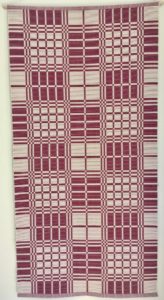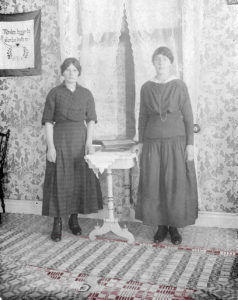Inspiration and Influences


Heritage. There was a rag rug in the laundry room, a piece of rug actually, with blocks of maroon and antique white. Mother said it came from Sweden. Her mother brought it with her when she emigrated in 1920. Not long after learning to weave I rediscovered the laundry room rug and a vintage photograph of my mormor, mother’s mother. She is a teenager in Sweden standing on that very rug in the living room of her childhood home. And so began my exploration of traditional Scandinavian weaving and craft.
Nature. The ebb and flow of the tides is not unlike the practice of weaving. It begins at low tide with ideas, designs, and sketches. At mid-tide the pace picks up. The loom is warped and weaving begins. As the project progresses, the process of weaving becomes meditative. The swing of the beater mimics the lapping of waves. The tide reaches its peak and begins to recede. Interest in the current project turns to thoughts of the next. Low tide approaches and weaving completes. The tide slacks, the tension on the warp is released, and the weaving cut from the loom.
Weaving and Craft. The interlacement of threads create fabric. Fabrics keep us warm, decorate our homes, and wrap us in tradition. Textiles are part of our holidays, ceremonies, and day-to-day life. They are so important to our human history and our individual lives that our language is full of words, idioms and metaphors associated textiles: the fiber of our being, the tapestry of life; we spin a tale, weave magic, surf the world wide web.
I like to think of “craft” as a verb, defined by Merriam Webster as “to make or produce with care, skill, or ingenuity.” The craft of weaving combines the physical skills and coordination needed to work the loom as well as knowledge of fiber and yarn and how their properties affect the weaving and finished product. This “material intelligence” is a concept that reaches beyond textiles. It’s knowing the right material, the right design, and the right tool for a job; knowing how to make, fix, adapt or design to your liking and needs.
In my studio hangs a gift from my father. It’s a picture of a young girl, head bowed, intent on threading a needle. An embroidery project rests in her lap. The caption is a quote by the Finnish-Swedish neurophysiologist Matti Bergström “the brain discovers what the fingers explore.” Printed as the introduction to an art or craft exhibit now long forgotten, the image and words capture the idea of material intelligence. The young girl is learning the soft feel of cloth and thread, the hard sharpness of the metal needle, and fine motor skills; all the very basics of material intelligence.
There are pictures and stories of me as a young girl doing similar activities: knitting, needlepoint, baking cookies, picking up stones, catching frogs. My little fingers were always busy, always exploring. I still like to explore, especially the natural world where I find color ways, textures, pattern and inspiration for my weaving.

